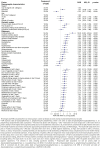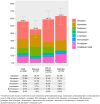Polypharmacy and potentially inappropriate prescribing of benzodiazepines in older nursing home residents
- PMID: 38833339
- PMCID: PMC11151799
- DOI: 10.1080/07853890.2024.2357232
Polypharmacy and potentially inappropriate prescribing of benzodiazepines in older nursing home residents
Abstract
Introduction: Previous research has raised concerns about high prevalence of drug-related problems, polypharmacy and inappropriate benzodiazepine prescribing in nursing homes (NHs) and confirmed lack of studies from Central and South-Eastern Europe. The aim of our study was to determine the prevalence and characteristics of polypharmacy, hyperpolypharmacy and inappropriate benzodiazepine prescribing in NH residents in Croatia.
Methods: Data from 226 older NH residents from five Croatian NHs were collected using the InterRAI Long-Term Care Facilities assessment form. The prevalence and determinants of polypharmacy/hyperpolypharmacy and patterns of inappropriate benzodiazepine prescribing were documented.
Results: The prevalence of polypharmacy (49.6%) and hyperpolypharmacy (25.7%) among NH residents was high. In our study, 72.1% of NH residents were prescribed at least one psychotropic agent, 36.7% used 2-3 psychotropics and 6.6% used 4+ psychotropics. Among benzodiazepine users (55.8%), 28% of residents were prescribed benzodiazepines in higher than recommended geriatric doses, 75% used them for the long term and 48% were prescribed concomitant interacting medications. The odds of being prescribed polypharmacy/hyperpolypharmacy were significantly higher for older patients with polymorbidity (6+ disorders, proportional odds ratio (POR) = 19.8), type II diabetes (POR = 5.2), ischemic heart disease (POR = 4.6), higher frailty (Clinical Frailty Scale (CFS ≥5); POR = 4.3) and gastrointestinal problems (POR = 4.8).
Conclusions: Our research underscores the persistent challenge of inappropriate medication use and drug-related harms among older NH residents, despite existing evidence and professional campaigns. Effective regulatory and policy interventions, including the implementation of geriatrician and clinical pharmacy services, are essential to address this critical issue and ensure optimal medication management for vulnerable NH populations.
Keywords: Nursing home residents; geriatric deprescribing; inappropriate benzodiazepine prescribing; polypharmacy/hyperpolypharmacy; psychiatric polypharmacy/hyperpolypharmacy.
Conflict of interest statement
No potential conflict of interest was reported by the author(s).
Figures
References
-
- Fialová D, Laffon B, Marinković V, et al. . Medication use in older patients and age-blind approach: narrative literature review (insufficient evidence on the efficacy and safety of drugs in older age, frequent use of PIMs and polypharmacy, and underuse of highly beneficial nonpharmacological strategies). Eur J Clin Pharmacol. 2019;75(4):1–14. doi: 10.1007/s00228-018-2603-5. - DOI - PubMed
MeSH terms
Substances
LinkOut - more resources
Full Text Sources
Other Literature Sources
Medical



